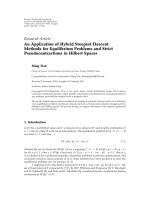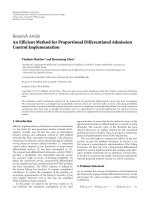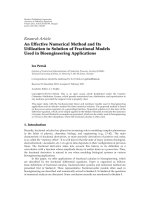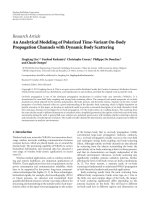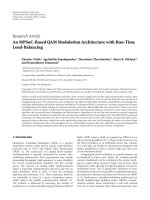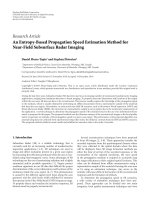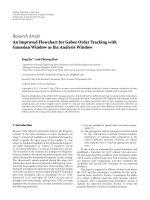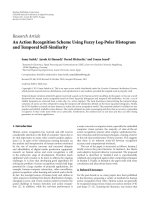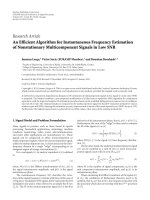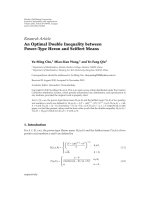Báo cáo hóa học: "Research Article An Inequality for the Beta Function with Application to Pluripotential Theory" doc
Bạn đang xem bản rút gọn của tài liệu. Xem và tải ngay bản đầy đủ của tài liệu tại đây (472.86 KB, 8 trang )
Hindawi Publishing Corporation
Journal of Inequalities and Applications
Volume 2009, Article ID 901397, 8 pages
doi:10.1155/2009/901397
Research Article
An Inequality for the Beta Function with
Application to Pluripotential Theory
Per
˚
Ahag
1
and Rafał Czy
˙
z
2
1
Department of Natural Sciences, Engineering and Mathematics, Mid Sweden University,
871 88 H
¨
arn
¨
osand, Sweden
2
Institute of Mathematics, Jagiellonian University, Łojasiewicza 6, 30-348 Krak
´
ow, Poland
Correspondence should be addressed to Per
˚
Ahag,
Received 4 June 2009; Accepted 22 July 2009
Recommended by Paolo Ricci
We prove in this paper an inequality for the beta function, and we give an application in
pluripotential theory.
Copyright q 2009 P.
˚
Ahag and R. Czy
˙
z. This is an open access article distributed under the
Creative Commons Attribution License, which permits unrestricted use, distribution, and
reproduction in any medium, provided the original work is properly cited.
1. Introduction
A correspondence that started in 1729 between Leonhard Euler and Christian Goldbach was
the dawn of the gamma function that is given by
Γ
x
∞
0
e
−t
t
x−1
dt
1.1
see, e.g., 1, 2. One of the gamma function’s relatives is the beta function, which is defined
by
B
a, b
1
0
t
a−1
1 − t
b−1
dt .
1.2
The connection between these two Eulerian integrals is
B
a, b
Γ
a
Γ
b
Γ
a b
.
1.3
2 Journal of I nequalities and Applications
Since Euler’s days the research of these special functions and their generalizations have had
great impact on, for example, analysis, mathematical physics, and statistics. In this paper we
prove the following inequality for the beta function.
Inequality A. For all n ∈ N and all p ≥ 0 p
/
0, p
/
1 there exists a number k>0 such that
k
npnp
/
np
B
p 1,kn
>B
p 1,n
. 1.4
If p 0, then we have equality in 1.4,andifp 1, then we have the opposite inequality for
all n ∈ N, k>0.
In Section 3 we will give an application of Inequality A within the pluripotential
theory.
2. Proof of Inequality A
A crucial tool in Lemma 2.2 is the following theorem.
Theorem 2.1. Let ψxΓ
x/Γx be the digamma function. Then for x>0 it holds that
ψ
x
>
1
x
1
2x
2
,ψ
x
> −
1
x
2
−
1
x
3
−
1
2x
4
.
2.1
Proof. This follows from 3, Theorem 8see also 4, 5.
Lemma 2.2. Let α : N × 0, ∞ → R be a function defined by
α
n, p
1
n
p
n p
ψ
n
− ψ
n p 1
,
2.2
where ψxΓ
x/Γx is the digamma function. Then αn, p
/
0 for all n ∈ N and all p>0
(p
/
1). Furthermore, αn, 10 for all n ∈ N.
Proof. Since ψx 1ψx1/x, we have that αn, 10, and
α
n, p
1
n
p − 1
n p
ψ
n
− ψ
n p
.
2.3
From the construction of α we also have that αn, 00. By using 2.3 we get that
∂α
∂p
n 1
n p
2
− ψ
n p
.
2.4
From Theorem 2.1 it follows that
∂α
∂p
<
n 1
n p
2
−
1
n p
−
1
2
n p
2
1 − 2p
2
n p
2
.
2.5
Journal of Inequalities and Applications 3
Thus,
∂α
∂p
< 0forp ∈
1
2
, ∞
.
2.6
Furthermore,
∂
2
α
∂p
2
−2
n 1
n p
3
− ψ
n p
,
2.7
and since ψ
x > −1/x
2
− 1/x
3
− 1/2x
4
Theorem 2.1,wegetthat
∂
2
α
∂p
2
<
−2
n 1
n p
3
1
n p
2
1
n p
3
1
2
n p
4
−2n
2
− 2n − 2p 2p
2
1
2
n p
4
,
2.8
which means t hat
∂
2
α
∂p
2
< 0forp ∈
0, 1
.
2.9
From 2.6, 2.9, and the fact that αn, 1αn, 00, we conclude that αn, p
/
0 for all
n ∈ N and all p>0 p
/
1.
Proof of Inequality A.
Case 1 p 0. The definition
B
a, b
1
0
t
a−1
1 − t
b−1
dt
2.10
yields that Ba, 1B1,a1/a.Thus,
kB
1,kn
1
n
B
1,n
,
2.11
which is precisely the desired equality.
Case 2 p 1. We will now prove that for all k>0 it holds that
k
2n1/n1
B
2,kn
≤ B
2,n
.
2.12
4 Journal of I nequalities and Applications
Inequality 2.12 is equivalent to
k
2n1/n1
1
kn 1
1
kn
≤
1
n
n 1
.
2.13
Hence, to complete this case we need to prove that for all k>0 we have that
k
n/n1
1
kn 1
≤
1
n 1
.
2.14
Let h : 0, ∞ → R be defined by
h
k
kn 1 − k
n/n1
n − k
n/n1
.
2.15
To obtain 2.14 it is sufficient to prove that h ≥ 0. The definition of h yields that
h
0
1, lim
k →∞
h
k
∞ ,h
k
n
1 − k
−1/n1
.
2.16
Thus,
a h has a minimum point in k 1;
b h is decreasing on 0, 1;
c h is increasing on 1, ∞;
d h10.
Thus, hk ≥ 0fork ≥ 0.
Case 3 p>0,p
/
1.Fixn ∈ N.LetF : 0, ∞ → R be the function defined by
F
k
k
npnp/np
B
p 1,kn
− B
p 1,n
.
2.17
This construction implies that F is continuously differentiable, and F10. To prove this
case it is enough to show that F
1
/
0. By rewriting Bp 1,kn with 1.3 the function F can
be written as
F
k
k
npnp/np
Γ
p 1
Γ
kn
Γ
kn p 1
− B
p 1,n
, 2.18
Journal of Inequalities and Applications 5
and therefore we get that
F
k
Γ
p 1
n p np
n p
k
np/np
Γ
kn
Γ
kn p 1
nk
npnp/np
Γ
kn
Γ
kn p 1
− Γ
kn
Γ
kn p 1
Γ
2
kn p 1
nk
np/np
B
kn, p 1
1
n
p
n p
k
ψ
kn
− ψ
kn p 1
.
2.19
Thus
F
1
nB
n, p 1
1
n
p
n p
ψ
n
− ψ
n p 1
,
2.20
where ψxΓ
x/Γx is the digamma function. This proof is then completed by using
Lemma 2.2.
3. The Application
We start this section by recalling some definitions and needed facts. A domain is an open and
connected set, and a bounded domain Ω ⊆ C
n
is hyperconvex if there exists a plurisubharmonic
function ϕ : Ω → −∞, 0 such that the closure of the set {z ∈ Ω : ϕz <c} is compact in
Ω, for every c ∈ −∞, 0; that is, for every c<0 the level set {z ∈ Ω : ϕz <c} is relatively
compact in Ω. The geometric condition that our underlying domain should be hyperconvex
is to ensure that we have a satisfying quantity of plurisubharmonic functions. By E
0
Ω we
denote the family of all bounded plurisubharmonic functions ϕ defined on Ω such that
lim
z → ξ
ϕ
z
0 for every ξ ∈ ∂Ω,
Ω
dd
c
ϕ
n
< ∞,
3.1
where dd
c
·
n
is the complex Monge-Amp
`
ere operator. Next let E
p
Ω, p>0, denote the
family of plurisubharmonic functions u defined on Ω such that there exists a decreasing
sequence {u
j
}, u
j
∈E
0
, that converges pointwise to u on Ω,asj tends to ∞,and
sup
j≥1
Ω
−u
j
p
dd
c
u
j
n
sup
j≥1
e
p
u
j
< ∞.
3.2
If u ∈E
p
Ω, then e
p
u < ∞ 6, 7. It should be noted that it follows from 6 that
the complex Monge-Amp
`
ere operator is well defined on E
p
. For further information about
pluripotential theory and the complex Monge-Amp
`
ere operator we refer to 8, 9.
The convex cone E
p
has applications in dynamical systems and algebraic geometry
see, e.g., 10, 11. A fundamental tool in working with E
p
is the following energy estimate
the proof can be found in 12,seealso6, 13, 14.
6 Journal of I nequalities and Applications
Theorem 3.1. Let p>0, and n ≥ 1. Then there exists a constant Dn, p ≥ 1, depending only on n
and p, such that for any u
0
,u
1
, ,u
n
∈E
p
it holds that
Ω
−u
0
p
dd
c
u
1
∧···∧dd
c
u
n
≤ D
n, p
e
p
u
0
p/pn
e
p
u
1
1/pn
e
p
u
n
1/pn
.
3.3
Moreover,
D
n, p
≤
⎧
⎪
⎨
⎪
⎩
1
p
n/n−p
, if 0 <p<1,
p
pan,p/p−1
, if p > 1,
3.4
Dn, 11 and an, pp 2p 1/p
n−1
− p 1.Ifn 1, then one follows [12] and
interprets 3.3 as
Ω
−u
p
Δv ≤ D
1,p
Ω
−u
p
Δu
p/p1
Ω
−v
p
Δv
1/p1
.
3.5
If Dn, p1 for all functions in E
p
, then the methods in 15 would immediately
imply that the vector space E
p
−E
p
, with certain norm, is a Banach space. Furthermore, proofs
in 15see also 6 could be simplified, and some would even be superfluous. Therefore, it
is important to know for which n, p the constant Dn, p is equal or strictly greater than one.
With the help of Inequality A we settle this question. In Example 3.2, we show that there are
functions such that, for all n ∈ N and all p>0 p
/
1, the constant Dn, p,in3.3, is strictly
greater than 1.
Example 3.2. Let B0, 1 ⊂ C
n
be the unit ball, and for α>0set
u
α
z
|
z
|
2α
− 1.
3.6
Hence,
dd
c
u
α
n
n!4
n
α
n1
|
z
|
2nα−1
dλ
n
,
3.7
Journal of Inequalities and Applications 7
where dλ
n
is the Lebesgue measure on C
n
. For β>0 we then have that
B
0,1
−u
α
p
dd
c
u
β
n
n!4
n
β
n1
B
0,1
1 −
|
z
|
2α
p
|
z
|
2nβ−1
dλ
n
n!4
n
β
n1
∂B
0,1
dσ
n
1
0
1 − t
2α
p
t
2nβ−1
t
2n−1
dt
n!4
n
β
n1
σ
n
∂B
0, 1
1
0
1 − t
2α
p
t
2nβ−1
dt
n!4
n
β
n1
2
π
n
n − 1
!
1
2α
1
0
1 − s
p
s
nβ/α−1
ds
n
4π
n
β
n1
α
B
p 1,
β
α
n
,
3.8
where dσ
n
is the Lebesgue measure on ∂B0, 1.Ifα β, then
B
0,1
−u
α
p
dd
c
u
α
n
n
4π
n
α
n
B
p 1,n
.
3.9
If we assume that Dn, p1inTheorem 3.1, then it holds that
n
4π
n
β
n1
α
B
p 1,
β
α
n
≤
n
4π
n
α
n
B
p 1,n
p/np
n
4π
n
β
n
B
p 1,n
n/np
.
3.10
Hence,
β
α
npnp/np
B
p 1,
β
α
n
≤ B
p 1,n
∀α, β > 0.
3.11
In particular, if β/α k, then we get that
k
npnp/np
B
p 1,kn
≤ B
p 1,n
.
3.12
This contradicts Inequality A. Thus, there are functions such that Dn, p > 1 for all n ∈ N and
all p>0 p
/
1.
Acknowledgments
The authors would like to thank Leif Persson for fruitful discussions and encouragement. R.
Czy
˙
z was partially supported by ministerial Grant no. N N201 367933.
8 Journal of I nequalities and Applications
References
1 P. J. Davis, “Leonhard Euler’s integral: a historical profile of the gamma function,” The American
Mathematical Monthly, vol. 66, pp. 849–869, 1959.
2 W. Gautschi, “Leonhard Euler: his life, the man, and his works,” SIAM Review, vol. 50, no. 1, pp. 3–33,
2008.
3 H. Alzer, “On some inequalities for the gamma and psi functions,” Mathematics of Computation, vol.
66, no. 217, pp. 373–389, 1997.
4 S. Koumandos, “Remarks on some completely monotonic functions,” Journal of Mathematical Analysis
and Applications, vol. 324, no. 2, pp. 1458–1461, 2006.
5 F. Qi, R Q. Cui, C P. Chen, and B N. Guo, “Some completely monotonic functions involving
polygamma functions and an application,” Journal of Mathematical Analysis and Applications, vol. 310,
no. 1, pp. 303–308, 2005.
6 U. Cegrell, “Pluricomplex energy,” Acta Mathematica, vol. 180, no. 2, pp. 187–217, 1998.
7 U. Cegrell, S. Kołodziej, and A. Zeriahi, “Subextension of plurisubharmonic functions with weak
singularities,” Mathematische Zeitschrift, vol. 250, no. 1, pp. 7–22, 2005.
8 M. Klimek, Pluripotential Theory, vol. 6 of London Mathematical Society Monographs, The Clarendon
Press, Oxford University Press, New York, NY, USA, 1991.
9 S. Kołodziej, “The complex Monge-Amp
`
ere equation and pluripotential theory,” Memoirs of the
American Mathematical Society, vol. 178, no. 840, 2005.
10 P.
˚
Ahag,U.Cegrell,S.Kołodziej, H. H. Pham, and A. Zeriahi, “Partial pluricomplex energy and
integrability exponents of plurisubharmonic functions,” Advances in Mathematics. In press.
11 J. Diller, R. Dujardin, and V. Guedj, “Dynamics of meromorphic maps with small topological degree
II: energy and invariant measure,” Commentrail Mathematici Helvetici. In press.
12 L. Persson, “A Dirichlet principle for the complex Monge-Amp
`
ere operator,” Arkiv f
¨
or Matematik, vol.
37, no. 2, pp. 345–356, 1999.
13 P.
˚
Ahag,R.Czy
˙
z, and H. H. Pha¸m, “Concerning the energy class ε
p
for 0 <p<1,” Annales Polonici
Mathematici, vol. 91, no. 2-3, pp. 119–130, 2007.
14 U. Cegrell and L. Persson, “An energy estimate for the complex Monge-Amp
`
ere operator,” Annales
Polonici Mathematici, vol. 67, no. 1, pp. 95–102, 1997.
15 P.
˚
Ahag and R. Czy
˙
z, “Modulability and duality of certain cones in pluripotential theory,” Journal of
Mathematical Analysis and Applications. In press.
